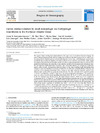Identificador persistente para citar o vincular este elemento:
https://accedacris.ulpgc.es/jspui/handle/10553/114531
| Título: | Carbon remineralization by small mesopelagic and bathypelagic Stomiiforms in the Northeast Atlantic Ocean | Autores/as: | Sarmiento Lezcano, Airam Nauzet Pilar Olivar, M. Peña, Marian Landeira Sánchez, José María Armengol Bové, Laia Medina Suárez, Ione Castellón, Arturo Hernández León, Santiago Manuel |
Clasificación UNESCO: | 3105 Peces y fauna silvestre 240119 Zoología marina 230606 Química de los hidratos de carbono |
Palabras clave: | Argyropelecus Cyclothone Non-Migrant Micronekton Respiration Rates |
Fecha de publicación: | 2022 | Publicación seriada: | Progress in Oceanography | Resumen: | The organic carbon resulting from photosynthesis in the upper ocean is transferred downward through the passive sinking of organic particles, physical mixing of particulate and dissolved organic carbon as well as active flux transported by zooplanktonic and micronektonic migrants. Several meso- and bathypelagic organisms feed in shallower layers during the nighttime and respire, defecate, excrete and die at depth. Recent studies suggest that migrant micronekton transport similar amounts of carbon to migrant zooplankton. However, there is scarce information about biomass and carbon flux by non-migratory species in the mesopelagic and bathypelagic zones. The non-migratory bristlemouth fishes (Cyclothone spp.) and partial migrator (A. hemigymnus) remineralise organic carbon at depth, and knowledge about this process by this fauna is lacking despite them having been referred to as the most abundant vertebrates on Earth. Here we show the vertical distribution of biomass and respiration of non-migratory mesopelagic fishes, during day and night, using the enzymatic activity of the electron transfer system (ETS) as a proxy for respiration rates. The study is focused on five Cyclothone species (C. braueri, C. pseudopallida, C. pallida, C. livida and C. microdon) and Argyropelecus hemigymnus. The samples were taken on a transect from the oceanic upwelling off Northwest Africa (20° N, 20° W) to the south of Iceland (60° N, 20° W). Cyclothone spp. showed, by far, the largest biomass (126.90 ± 86.20 mg C·m−2) compared to A. hemigymnus (0.54 ± 0.44 mg C·m−2). The highest concentrations of Cyclothone spp. in the water column were observed between 400 and 600 m and from 1000 to 1500 m depths, both during day and night. For the different species analysed, ETS activity did not show significant differences between diurnal and nocturnal periods. The total average specific respiration of Cyclothone spp. (0.02 ± 0.01 d-1) was lower than that observed for A. hemigymnus (0.05 ± 0.02 d-1). The average carbon respiration of Cyclothone spp. was 2.22 ± 0.81 mg C·m−2·d-1, while it was much lower for A. hemigymnus (0.04 ± 0.03 mg C·m−2·d-1). The respiration of Cyclothone spp. was lower in the bathypelagic than in the mesopelagic zone (0.84 ± 0.48 vs 1.36 ± 1.01 mg C·m−2·d-1, respectively). These results, to our knowledge, provide the first account of remineralisation by this community in the meso and bathypelagic zones of the ocean. | URI: | https://accedacris.ulpgc.es/handle/10553/114531 | ISSN: | 0079-6611 | DOI: | 10.1016/j.pocean.2022.102787 | Fuente: | Progress in Oceanography [ISSN 0079-6611], v. 203, (Abril 2022) |
| Colección: | Artículos |
Citas SCOPUSTM
14
actualizado el 08-jun-2025
Citas de WEB OF SCIENCETM
Citations
14
actualizado el 08-jun-2025
Visitas
50
actualizado el 27-ene-2024
Descargas
31
actualizado el 27-ene-2024
Google ScholarTM
Verifica
Altmetric
Comparte
Exporta metadatos
Los elementos en ULPGC accedaCRIS están protegidos por derechos de autor con todos los derechos reservados, a menos que se indique lo contrario.
